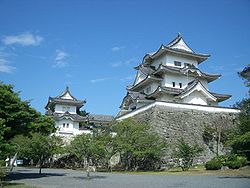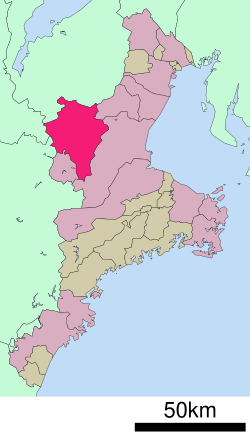Iga, Mie
Iga 伊賀市 | |
|---|---|
 | |
 Location of Iga in Mie Prefecture | |
| Coordinates: 34°46′N 136°8′E / 34.767°N 136.133°E | |
| Country | Japan |
| Region | Kansai |
| Prefecture | Mie |
| Government | |
| • Mayor | Sakae Okamoto |
| Area | |
• Total | 558.17 km2 (215.51 sq mi) |
| Population (August 31, 2021) | |
• Total | 88,895 |
| • Density | 160/km2 (410/sq mi) |
| Time zone | UTC+9 (Japan Standard Time) |
| Address | 116 Ueno Marunouchi, Iga-shi, Mie-ken 518-8501 |
| Climate | Cfa |
| Website | Official website |
| Symbols | |
| Bird | Green pheasant |
| Flower | Sasayuri (Lilium japonicum) |
| Tree | Japanese red pine |

Iga (伊賀市, Iga-shi) is a city located in Mie Prefecture, Japan. As of 31 August 2021, the city had an estimated population of 88,895 in 40,620 households and a population density of 160 persons per km².[1] The total area of the city is 558.23 square kilometres (215.53 sq mi).
Geography
Iga is located in northwestern Mie Prefecture. The northeastern part of the city is in the Suzuka Mountains, and the northwestern part is in the Shigaraki Plateau. The southwestern of the city is the Yamato Highlands, and the southeastern portion is a basin surrounded by the Nunobiki Mountains. The area is very hilly. Since it is on the upper reaches of the Kizu River, which belongs to the Yodo River system, and borders on Shiga, Nara, and Kyoto prefectures, although Mie prefecture is classified as part of the Tōkai region, the Iga region, including Nabari city, is designated as part of the Kansai region.
Neighboring municipalities
Kyoto Prefecture
Mie Prefecture
Nara Prefecture
Shiga Prefecture
Climate
Iga has a Humid subtropical climate (Köppen Cfa) characterized by warm summers and cool winters with light to no snowfall. The average annual temperature in Iga is 14.6 °C (58.3 °F). The average annual rainfall is 1,440.9 mm (56.73 in) with June and July as the wettest month. The temperatures are highest on average in August, at around 26.7 °C (80.1 °F), and lowest in January, at around 3.5 °C (38.3 °F).[2]
| Climate data for Ueno, Iga (1991−2020 normals, extremes 1937−present) | |||||||||||||
|---|---|---|---|---|---|---|---|---|---|---|---|---|---|
| Month | Jan | Feb | Mar | Apr | May | Jun | Jul | Aug | Sep | Oct | Nov | Dec | Year |
| Record high °C (°F) | 17.8 (64.0) |
22.1 (71.8) |
25.7 (78.3) |
30.2 (86.4) |
33.8 (92.8) |
35.7 (96.3) |
38.0 (100.4) |
38.8 (101.8) |
36.5 (97.7) |
32.2 (90.0) |
26.3 (79.3) |
22.1 (71.8) |
38.8 (101.8) |
| Mean daily maximum °C (°F) | 8.3 (46.9) |
9.4 (48.9) |
13.4 (56.1) |
19.2 (66.6) |
24.0 (75.2) |
26.9 (80.4) |
31.0 (87.8) |
32.5 (90.5) |
28.1 (82.6) |
22.2 (72.0) |
16.5 (61.7) |
10.9 (51.6) |
20.2 (68.4) |
| Daily mean °C (°F) | 3.5 (38.3) |
4.0 (39.2) |
7.3 (45.1) |
12.7 (54.9) |
17.9 (64.2) |
21.8 (71.2) |
25.8 (78.4) |
26.7 (80.1) |
22.8 (73.0) |
16.7 (62.1) |
10.7 (51.3) |
5.7 (42.3) |
14.6 (58.3) |
| Mean daily minimum °C (°F) | −0.6 (30.9) |
−0.5 (31.1) |
2.0 (35.6) |
6.8 (44.2) |
12.4 (54.3) |
17.5 (63.5) |
21.9 (71.4) |
22.6 (72.7) |
18.7 (65.7) |
12.1 (53.8) |
5.7 (42.3) |
1.2 (34.2) |
10.0 (50.0) |
| Record low °C (°F) | −9.6 (14.7) |
−9.6 (14.7) |
−7.8 (18.0) |
−4.8 (23.4) |
−0.8 (30.6) |
5.6 (42.1) |
11.3 (52.3) |
11.1 (52.0) |
5.1 (41.2) |
−1.0 (30.2) |
−5.0 (23.0) |
−9.5 (14.9) |
−9.6 (14.7) |
| Average precipitation mm (inches) | 50.9 (2.00) |
60.0 (2.36) |
104.2 (4.10) |
104.2 (4.10) |
139.7 (5.50) |
194.3 (7.65) |
194.3 (7.65) |
136.4 (5.37) |
187.3 (7.37) |
146.7 (5.78) |
72.1 (2.84) |
50.8 (2.00) |
1,440.9 (56.73) |
| Average precipitation days (≥ 1.0 mm) | 6.5 | 7.2 | 9.9 | 9.5 | 9.8 | 12.2 | 11.9 | 8.6 | 10.0 | 9.1 | 6.9 | 6.8 | 108.4 |
| Average relative humidity (%) | 71 | 70 | 69 | 67 | 69 | 75 | 76 | 75 | 77 | 77 | 76 | 73 | 73 |
| Mean monthly sunshine hours | 125.0 | 121.0 | 154.7 | 174.8 | 183.4 | 132.8 | 155.3 | 191.7 | 142.0 | 143.4 | 136.1 | 135.0 | 1,806.9 |
| Source: Japan Meteorological Agency[2][3] | |||||||||||||
Demographics
Per Japanese census data,[4] the population of Iga has remained relatively constant over the past 60 years.
| Year | Pop. | ±% |
|---|---|---|
| 1960 | 99,821 | — |
| 1970 | 92,841 | −7.0% |
| 1980 | 95,582 | +3.0% |
| 1990 | 97,752 | +2.3% |
| 2000 | 101,527 | +3.9% |
| 2010 | 97,215 | −4.2% |
History
The area around the modern city of Iga corresponds to a portion of ancient Iga Province. The area was noted in the Sengoku period as one of the centers for ninjutsu. From around the 1460s until 1581, the province of Iga was an effectively autonomous confederation governed by a council of local ninja families. The town developed in the Edo period under the Tokugawa Shogunate as a castle town under Iga Ueno Castle. Iga is known as the birthplace of the haiku poet Matsuo Bashō and the home of the ninja Hattori Hanzō.
The town of Ueno was established on April 1, 1889 with the creation of the modern municipalities system. It was raised to city status on September 10, 1941. On November 1, 2004 Ueno merged with the towns of Iga and Ayama, the villages of Shimagahara and Ōyamada (all from Ayama District); and the town of Aoyama (from Naga District) to form the city of Iga.
Government
Iga has a mayor-council form of government with a directly elected mayor and a unicameral city council of 22 members. Iga contributes two members to the Mie Prefectural Assembly. In terms of national politics, the city is part of Mie 3rd district of the lower house of the Diet of Japan.
Economy
Iga is traditionally known as a center for Kumihimo, a traditional braiding art, with several artisans still in activity. The city is a regional commercial center and the local economy is dominated by agriculture and seasonal tourism. Since Iga is geographically located between Osaka and Nagoya, the number of factories located along the Meihan National Highway is increasing, especially due to the convenience of logistics.
Education
Iga has 19 public elementary schools and ten public middle schools operated by the city government and three public high schools operated by the Mie Prefectural Department of Education. The city also has two private high schools and one combined private middle/high school.
International schools
- Colégio Positivo - Brazilian primary school,[5] founded in 2013.
Transportation
Railway
- Tsuge - Shindō - Sanagu - Iga-Ueno - Shimagahara
■ Iga Railway – Iga Line
- Iga-Ueno - Nii - Nishi-Ōte - Uenoshi - Hirokōji - Kayamachi - Kuwamachi - Idamichi - Ichibe - Inako - Maruyama - Uebayashi - Hido - Iga-Kambe
Highway
 Meihan Expressway
Meihan Expressway National Route 25
National Route 25 National Route 163
National Route 163 National Route 165
National Route 165 National Route 368
National Route 368 National Route 422
National Route 422
Local attractions
Two of Iga's main tourist attractions are the Iga Ueno Castle and the Iga-ryū Ninja Museum (the area around the city being the historical home of the famous Iga Ninja). There is also an annual Iga Ueno Ninja Festa ninja festival (April 1 to May 6).
Other not so well known attractions include:
- Otogitoge Pass is one pass that Tokugawa Ieyasu passed over as he hurriedly crossed Iga to return to Okazaki, helped along by the people of Iga and Koka, during the Honnoji War.
- Momochi Fortress is the fortress of Momochi Tanbanomikami, who is said to be one of the three great ninja, and nearby is Seiunzenji, where his grave is located.
- Sainenji Temple is a Jodoshu (Pure Land) temple and is the burial place of Fujibayashi Samujiyasutake, the author of one of the great books of ninjutsu, "Bansenshukai".
- Fujiwara no Chikata Kutsu is the castle of Fujiwara no Chikata who appears in the Taiheiki, or Records of Great Peace.
- A statue of Sonic the Hedgehog which was erected in the 1990s for a Sega World location in Kadoma. The statue's owner died, and it is now owned by their children. It was deteriorating until 2020, when the owners finally restored it. [6]
- One of the last operational examples of a first generation Yamaha Music Siren is located on top of the Iga City Hall and can be heard playing music at set times throughout the day. The siren uses a system of dampers around ten choppers, each with different sized holes, in order to produce music. Due to Yamaha ending support for all models of the Music Siren, it has become extremely difficult to find examples still in operation. [7]
International relations
 Jurong, Jiangsu, China
Jurong, Jiangsu, China
Notable people from Iga
- Matsuo Bashō, poet
- Hakaru Hashimoto, medical scientist
- Akiko Iwasaki, immunologist and professor at Yale University
- Igano Kabamaru, ninja
- Jirō Kawasaki, politician
- Shuto Machino, professional soccer player
- Genichi Mitsuhashi, first Ninja studies graduate
- Wasabi Mizuta, voice author
- Ichizo Nakata, professional soccer player
- Koji Nishimura, professional soccer player
- Kippei Shiina, actor
- Chiyonokuni Toshiki, sumo wrestler
- Kazuhiro Yamaji, actor, voice actor
See also
References
- ^ "Iga city official statistics" (in Japanese). Japan.
- ^ a b 平年値(年・月ごとの値) (in Japanese). Japan Meteorological Agency. Retrieved February 17, 2017.
- ^ 観測史上1~10位の値(年間を通じての値) (in Japanese). (1981–2010). Retrieved February 19, 2017.
- ^ Iga population statistics
- ^ "Escolas Brasileiras Homologadas no Japão" (Archive). Embassy of Brazil in Tokyo. Retrieved on October 13, 2015.
- ^ Morrissy, Kim. "Mysterious Sonic the Hedgehog Statue in Japanese Mountains Gets Refurbished". Anime News Network. Retrieved 26 October 2020.
- ^ "'Music sirens,' erasers of bad war memories, drop in number | The Asahi Shimbun: Breaking News, Japan News and Analysis". The Asahi Shimbun. Retrieved 2023-07-08.
External links
- Iga City official website (in Japanese)
 Iga travel guide from Wikivoyage
Iga travel guide from Wikivoyage Geographic data related to Iga, Mie at OpenStreetMap
Geographic data related to Iga, Mie at OpenStreetMap



